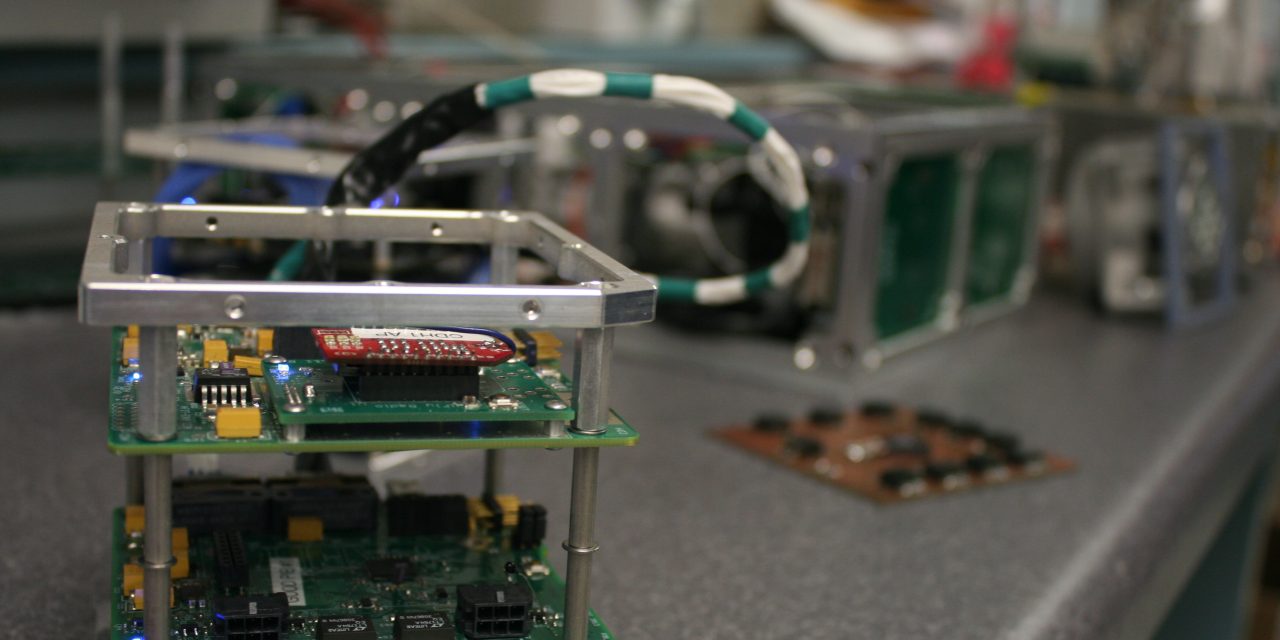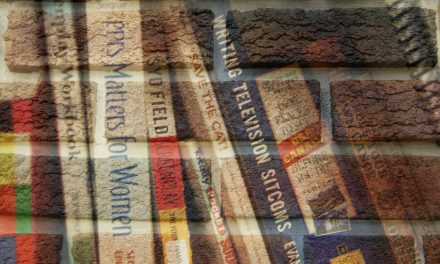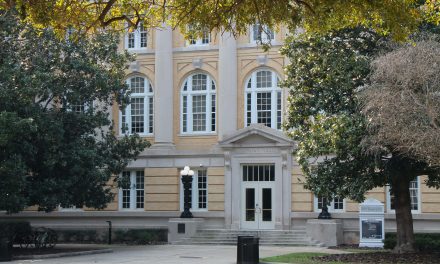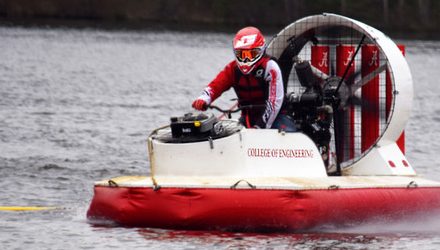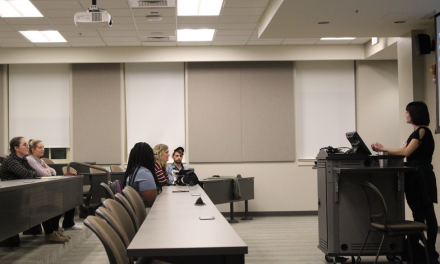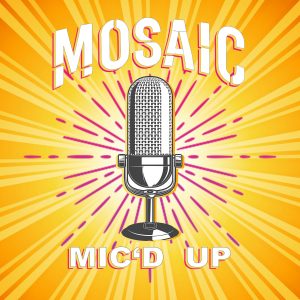From brilliantly colored, distant galaxies and burning stars to vast, empty darkness and the coldest temperatures possible, the many extremes of space lead to a single conclusion: space is cool. This conviction and very little else drove a handful of students to create a one-of-a-kind organization to bring space to The University of Alabama.
 The idea began with a team of engineering students competing in a NASA competition that challenged them to design and build a small satellite with certain specifications and mission requirements. Fascinated by space and frustrated by the lack of other opportunities to engage their interest, the students led the initiative to begin a local chapter of Students for the Exploration and Development of Space.
The idea began with a team of engineering students competing in a NASA competition that challenged them to design and build a small satellite with certain specifications and mission requirements. Fascinated by space and frustrated by the lack of other opportunities to engage their interest, the students led the initiative to begin a local chapter of Students for the Exploration and Development of Space.
“In 2013, the Aerospace Engineering and Mechanics department was really only aeronautically focused,” said Joseph Olmstead, an Honors student majoring in aerospace engineering, and president of the UA SEDS chapter. “We were just trying to create the opportunity for ourselves to do something we couldn’t get from our classes.”
SEDS is an international, chapter-based, nonprofit organization intended to inspire and equip college students to impact space discovery and development. The UA chapter began to come together in the spring of 2014.
“We were just a bunch of kids that loved space, and we would go to a room and talk about it,” said Cassidy McCool, the current vice president of SEDS.
According to McCool and Olmstead, SEDS faced the challenges of any new student group at UA. They slogged through the lengthy process of writing a constitution, filling out reams of paperwork and attending mandatory meetings. By Fall 2014, however, they were an official SEDS chapter, and an official UA student organization. They promptly began looking for ways to convince others of the importance of space exploration.
“Cell phones, pacemakers, cordless tools, everything that’s made aviation and travel on roads safe – that’s all come out of investment and research done for space exploration,” Olmstead said. “That’s part of the reason we do it. It’s not just, ‘Can we go there?’ It’s, ‘What does getting there teach us about here?’”
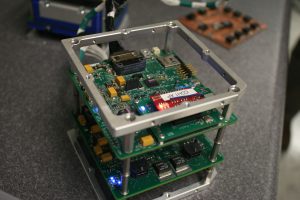
The Air Force Institute of Technology donated this model Cube Satellite or “CubeSat” to the students in SEDS.
Instead of routine meetings, SEDS holds a variety of events such as an observation night at the Gallalee Hall observatory and going to see the recent movie, The Martian. SEDS also provides optional outlets for working with space hardware; their most recent project is designing and constructing a CubeSat, a tiny satellite capable of being put into orbit for a several-month-long mission.
“We want people to understand that spaceflight affects everyone,” McCool said. “There’s an infinite number of things that can be transferred from space technologies to technologies used on Earth and people don’t understand that and that’s why [spaceflight] is so very important.”
Dr. Richard Branam, a recent addition to the Aerospace Engineering and Mechanics department, is the current sponsor of SEDS. Branam launched the CubeSat project to give students more practical, hands-on experience with space technology. Having spent 25 years working on rockets and space propulsion for the Air Force, he wants to see more space activities at UA.
“[SEDS] is more than just a social club,” Branam said. “It should also be a bit of an incubator for future-thinking ideas. So we’ve got a cubesat, now what? Let’s send one to the moon or to Mars or let’s do something even more exotic; let’s put some unknown propulsion system on board. It would be a great place to spend some time to discuss those ideas.”
SEDS seeks to incorporate students from as many diverse backgrounds and majors as possible. Branam, Olmstead and McCool all see diversity as crucial to the future of space exploration and even to the advancement of technology here on Earth.
“We don’t want just engineers; we want artists, and others in the group because they bring a lot to it,” Branam said. “Students from the College of Arts and Sciences and students from engineering kind of think about things differently, and if you can get them together, there are ways of making that beneficial to everyone, especially when you’re talking about design teams.”
 While SEDS is an entirely student-led initiative with almost no outside help, it has been part of a broader push for the promotion of space-related activities at UA. Since 2013, three new astronautics professors have been hired, courses on space-related topics have been added primarily by Branam and department head Dr. John Baker, and there are now several space-related projects students can be involved in, including the CubeSat team.
While SEDS is an entirely student-led initiative with almost no outside help, it has been part of a broader push for the promotion of space-related activities at UA. Since 2013, three new astronautics professors have been hired, courses on space-related topics have been added primarily by Branam and department head Dr. John Baker, and there are now several space-related projects students can be involved in, including the CubeSat team.
“This university and the students here deserve an opportunity to get that ‘astro’ experience – that hands-on learning, looking at the actual hardware,” Branam said. “This aerospace department doesn’t have any space. But it needs it, and our students deserve it. It’s time for us to make sure we’re giving them every opportunity they deserve.”
SEDS is also reaching out into the community by launching the Tuscaloosa Rocketry Challenge among local middle schools. A program test run was conducted at Hillcrest Middle School in the Spring of 2015.
“The Tuscaloosa Rocketry Challenge consists of a three-day lecture series where we talk about the importance of space,” McCool said. “We teach the kids about the basic functionalities of rockets and then we build water filled rockets from recyclable materials so it’s super cheap and really cool.”
The competition proved successful, and this coming spring, SEDS expects to have four middle schools and over 2,000 students participate. They are also seeking other organizations on campus to join them in this effort to inspire young students.
“If you want to make the world a better place, there are many different ways to do it,” Branam said. “Education is one of those infinitely valuable things. The more people that are educated, the better, and if it’s in some subject they enjoy, like space, then they can share that information with lots of other people.”
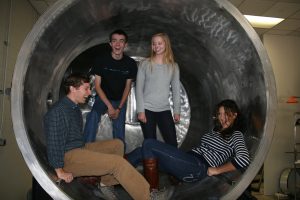
SEDS officers Joseph Olmstead, Matthew Culver, Kara Parks and Cassidy McCool sit inside of a vacuum chamber in Branam’s lab.
Though SEDS is only in its second official year on campus, they have already made great strides in promoting space involvement at the university and in Tuscaloosa and look forward to doing even more in the future. To those involved, SEDS is far more than just another student organization; it is a catalyst for change both on and off the planet.
“Have you ever wondered what it would be like to visit another planet?” Branam asked. “That’s the whole point of space exploration. Have you ever wondered, ‘What if things were different?’”

